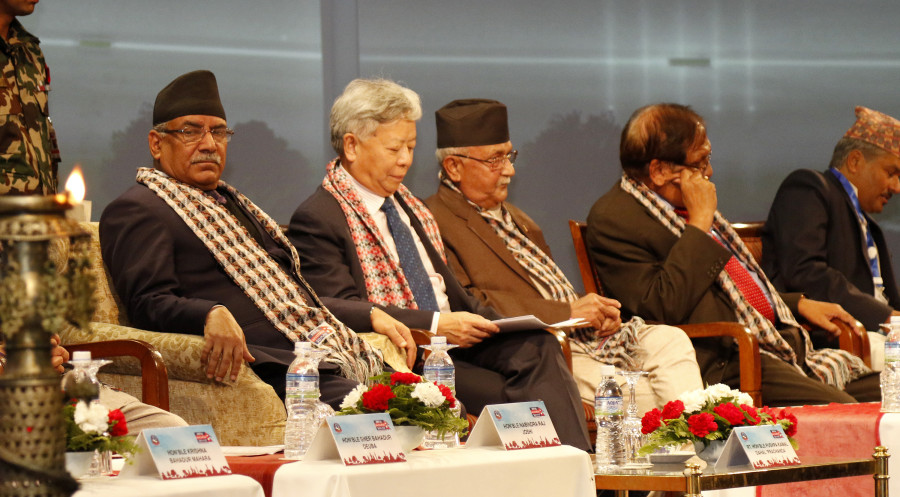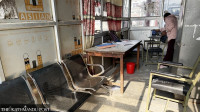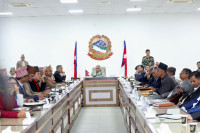National
All-male panels are on their way out, but women’s representation remains tokenistic
Instead of acknowledging that women have valuable contributions to make, they are often limited to women-specific panels or are placed as moderators.
Elisha Shrestha
“Kick off @ Nepal Investment Manference full of #Manels. I am all for #InvestInNepal but how in the world are we supposed to achieve economic development without the participation of half the population,” wrote a female participant on Facebook.
The only panel with a majority of women was the ‘Women in Business’ panel with five women and three men in conversation.
This is often the case with the numerous conferences, summits and programmes that are organised all year round in the Capital. The panels consist of majority men, with just a few women thrown in simply for representation. Instead of honestly acknowledging that women have valuable contributions to make to these events, women are often circumscribed within women-specific panels or are placed as moderators.
Manushi Yami Bhattarai, a political leader from the Samajbadi Party who has long been vocal about a host of socio-political issues, said that she is often side-lined when it comes to taking part in different public platforms to voice opinions on serious political issues.
“In the initial days of my political career, I was often asked to either distribute garlands to guests or moderate all-male panel discussions,” she said.
At the recently held Sagarmatha Sambaad too, there was a staggering difference in the number of male and female speakers. Out of a total of 23 speakers, only four were female.
The reasoning that organisers and panellists provide when questioned on the lack of women representation is that there aren’t many female experts in the fields of science, technology and politics.
Nishchal Nath Pandey, who moderated an all-male panel discussion on ‘Transformational Solutions’ at the Sagarmatha Sambaad, pointed out that there is often a problem finding female speakers in specialised fields.
“It is difficult to ensure gender representation on some topical issues since there might not be a relevant female expert,” said Pandey, who is director of the Centre for South Asian Studies.
While it is true that there are fewer women in leadership positions, that by itself is emblematic of the lack of opportunities for women to get to such top positions. So this cannot be an excuse to completely exclude or underrepresent women in public debates, says Narayani Devkota, a sociologist at Tribhuvan University.
“Women are out there, in every field. You just have to look harder,” said Devkota.
This is not just a Nepal problem; it is a fact of patriarchy all over the world. A 2013 study of TED talks found that male speakers outnumbered females by a ratio of 3-1. And according to 2018 survey by Bizzabo, an event software company, of the 60,000 speakers analysed at mostly private sector events in 23 countries over the last five years, men outnumbered women by 2-1.
In recent years, there has been a vocal outcry against all-male panels, informally called ‘manels’. People are quick to shame these manels on social media for making no effort to include any women. In response to this criticism, organisers today seem to be making more of an effort to include women on panels, but women are reluctant to embrace this wholly as they see it as a form of tokenism—something that organisers are only doing because they have to, not because they genuinely value the opinions and expertise of women.
“Once, I was approached to be a speaker on a panel simply because they needed a woman. While I am vocal against the invisibility of female speakers in public platforms, I also believe that approaching women only to tick the ‘female’ quota box is actually an insult to their potential,” said Bhattarai. “Such attempts can end up looking superficial rather than genuine.”
Pandey, however, believes that it is inappropriate to call tokenism for including one woman panellist in an attempt to end the ‘all-male’ panel. Instead of viewing women's participation in tokenistic terms, including at least one woman panellist should be viewed as being inclusive.
“Rather than creating a fuss about it, we need to be cognizant of the fact that we are becoming more aware of gender equality,” said Pandey.
Some organisers, however, claim to be gender-blind when it comes to crafting panels for discussion.
Kumar Raj Kharel, a member of Sagarmatha Sambaad secretariat, said that the panellists at the Sambaad were selected based on their expertise, rather than their gender, which panellist Bhawani Rana, president of the Federation of Nepalese Chambers of Commerce and Industry (FNCCI), agreed with.
“With 16 years of career in the investment sector, I believe that I am as qualified as any male counterparts to contribute to political and economic discourse,” said Rana, who was the sole female member in a five-person panel at the Sambaad.
But when there is just one woman, no matter how qualified, on a male-dominated panel, they are often reduced to a token woman who represents the opinions of all women, ignoring the vast diversity among women.
In order to move away from such tokenistic displays, Devkota feels that there should be at least 33 percent representation of women in any panel discussions, which she believes is achievable. And it is important to ensure that women are represented in discussions that impact economic and political decisions, not just ‘women’s issues’.
In an attempt to put an end to men-only conference panels and promote diversity, last year, Saathi, an organisation working for gender equality, launched the ‘Say No to All Male Panel’ signature campaign.
According to Uma Shah, president of Saathi, she and her female colleagues were motivated to undertake the campaign because of their own experience of attending conferences with only male speakers.
“There is a trend of including many women speakers only on women’s issues while they are made invisible when it comes to other issues,” said Shah.
Although Shah believes that campaign is an effort to ensure that the female population is also equally represented, a better gender balance is difficult to meet without the support of male counterparts.
“Until and unless male speakers too protest when organisers do not show a strong commitment to diversifying the makeup of their panellists, the underrepresentation of women will continue,” said Shah.




 18.12°C Kathmandu
18.12°C Kathmandu (1).jpg)















